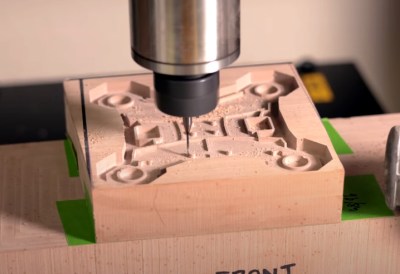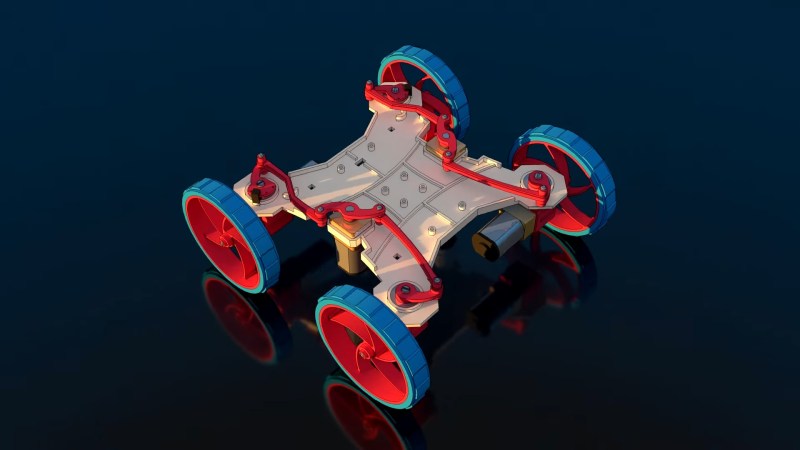At first glance, you might think the Omnibot v3 wasn’t anything more than a basic 3D printed robotics platform, but you’d be wrong on both counts. There’s actually no 3D printed parts on the build, and while you could describe the platform as simplistic, calling it basic certainly doesn’t do the clever design justice. In the video after the break, creator [Michal] takes us through the process of designing and building this high quality bot.
The build starts with huge amounts of time and effort in a CAD program designing the Omnibot v3 with its four wheel steering and ability to do fancy things like spin in place. With the CAD and 3D renders out of the way, the process of transforming the digital into the physical began with a CNC router.
 Rather than routing the individual components out of a suitable material, [Michal] cut forms. Those forms were made only for the creation of silicone molds. Those silicon molds where then used to pour the actual parts with polyurethane resin. It is these resin parts that make up the actual Omnibot v3, which is manually demonstrated at the end of the video.
Rather than routing the individual components out of a suitable material, [Michal] cut forms. Those forms were made only for the creation of silicone molds. Those silicon molds where then used to pour the actual parts with polyurethane resin. It is these resin parts that make up the actual Omnibot v3, which is manually demonstrated at the end of the video.
All in all, it’s a neat project with a neat process. If we were to stop here, things would be mostly complete and you’d click on to the next great Hackaday article. But there’s more to be had here. You see, [Michal] is also fellow behind the Guerrilla guide to CNC and resin casting. In his own words: “CNC machining and resin casting are an underappreciated method for producing engineering-grade parts, but the process is fast, predictable, and garage-friendly.” After seeing the results, we can’t help but to agree.
By the way, before anybody in the comments can yell “DUPE!”, we already know. You see, we featured the Guerrilla guide to CNC and resin casting once before, almost exactly 11.5 years ago! It’s been updated since then, and appears to be an absolute gold mine of information for anybody wanting to walk in [Michal]’s shoes.















Resin casting is great, but I’m not sure I’d call it garage freindly – they tend to be unheated/cooled and resin working times are temperature affected, and so can be the final parts mechanical properties.
Also for small stuff its a massive pain to mix a small enough amount of resin, so I think looking at this stuff some of the parts are on the border line of too small to mix a properly sized batch – which for me means either have other mold to make alongside that part, or make the molds for those parts actually make 3 or 4 units worth.
The other thing that gets you with resin is working time to cure time, pick short pot life and it is cured reasonable quickly, can get a few casts in the same mold in a day, if you can manage to work fast enough for the short pot life. Get the longer pot life and it could take 3 or 4 days to really be ready to demold, and a week or more for full setting (but it is as mentioned earlier temperature dependent too) which means you run out of surfaces to set molds on while they cure (at least I will, even with the shorter cure time stuff too)…
My overall point being for something like this you might be better off machining on your CNC a suitable material for each part rather than dealing with the fumes, time and mess of resin casting (assuming you have the CNC). It is a great technique but from my experience with how resin and silicon mold work eats space and often for a substantial time, also then considering the cost of resin to stock material suitable for these parts I would suggest the main body at least, probably the linkage arms too are better off being CNC milled with just the wheels cast (as the body and linkage arms are pretty flat so there isn’t going to be vast amounts of chips to be made from correctly sized stock, where the wheels you are throwing away 90% maybe even more of the stock material…
Half of your comment can be shortened to “If you don’t know what you’re doing, you’re going to have issues”, and that’s true of any manufacturing process.
Not really, as even knowing what you doing some of the parts they are making and how they set up the mold would be better off done by other methods in most situations – and my entirely point is this looks like the wrong process for the job at hand even though you know what you are doing – as the downsides the method comes with are problematic enough even for a master – with the reasoning as to why its perhaps not the best choice.
Cool, please share the link to your own exhaustive guide to resin casting developed over more than a decade, and I’ll be happy to compare it with the one linked in this article.
Hey, no one is saying that the resin casting method does not work – just that there are downsides and other processes might save workshop space, time and effort.
What an interesting concept and how nicely executed, really cool.
That guide is so amazing! I remember the original post about it and have been using the guide since.
Recently I have made it mandatory reading for my students.. it’s great for introducing the molding and casting concepts
The Guerrilla Guide has been my bible for years. He literally taught me everything I know about CNC and resin casting, and because of that, I actually get really great results.
One thing I do like about this project is that it uses N20 motors.
From your favourite “direct from china” store you can also get these motors with quadrature HALL encoder on the motor shaft.
On the pictures it looks like a black disk on the motor, and this disk is a multi-pole magnet It can have 4 to 16 or so poles, and this is plenty to get a fairly accurate position when combined with the gearbox ratio.
Apart from that. This way of filming is not my thing, I don’t like the “exciting” music and the short flashes with intermittend black pictures and no talk, so I skipped briefly through the video.
One thing every Hackaday contributor REALLY ought to know, is the distinction between silicon and silicone.
Hey there @BrightBlueJim, you know, this Hackaday contributor definitely knows the difference between the two, but the spelling differents alluded me. Thanks for the correction!
Nah you just go in for the William Shaksper spelling methodology, if it would make the right sort of word sound its good enough! Heck the guy didn’t even spell his own name consistently!
(This is my goto excuse for when my dyslexic brain fails to notice the spelling checker I lean so heavily on has picked the ‘wrong’ variety)
Eluded
Whooosh!
They should check to make sure there isn’t a trademark on omnibot. Radio Shack sold a line of Omnibot toy robots in the 80s
I wonder if you could use those hot water moldable thermoplastics to make the molds instead of silicone.
Another kind of mold material is “Composimold”. Melts in a microwave or you can use a double boiler on a hotplate. Melt it, cast it, let it cool. It’s reusable too. They even have a food safe version for casting custom shaped candy into the molds.
Look around on the web and you can find a DIY recipe for this stuff.
There are of course a couple of requirements for what you’re casting Composimold or the DIY version over. 1. it has to be able to withstand the temperature of the melted mold material. IT’S TOO HOT FOR BODY PARTS! 2. what it’s being poured onto cannot be porous. The stuff will stick like glue to cardboard, wood, foam etc unless it’s been sealed with something that fills all the pores and leaves a reasonably smooth surface. 3. the material will solidify with bubbles in it, so if you plan to do pressure casting in these molds, you’ll want to be able to get the freshly cast mold into a pressure or vacuum chamber FAST before it cools too much to crush or pop the bubbles. If you have a way to melt it while it’s in a partial vacuum, that could reduce or eliminate the bubbles.
Composimold and the DIY version are non-toxic. IIRC the only difference between regular and food safe is the food safe version is made with glycerine that meets FDA food additive specifications.